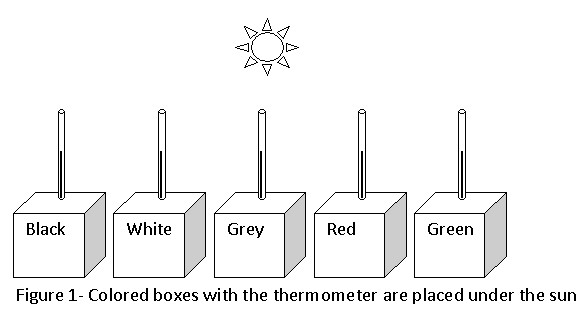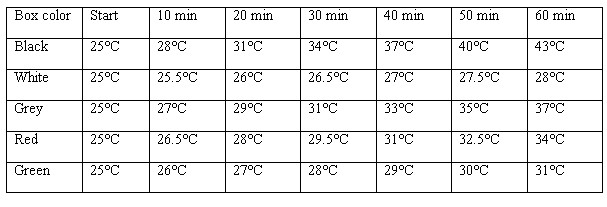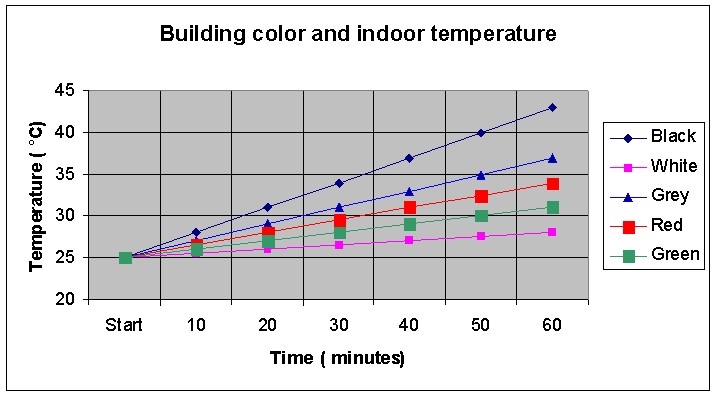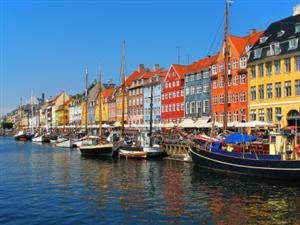| Complexity level: | 4 |
| Project cost ($): | 20 |
| Time required: | 2 hours to prepare, 1 hour for observation |
| Material availability: | Easily found |
| Safety concerns: |
Hypothesis
Black and darker colored buildings will have warmer indoor temperatures compared to white and lighter colored buildings.
Overview
Light Absorption
Light is in fact electromagnetic radiation. It is visible to the human eye in the frequency range between 400-700 terahertz. When light strikes an object it can be reflected (like in mirrors), transmitted (through a transparent object like glass) or absorbed. An object may transmit only a certain frequency of light, while absorbing all other frequencies. For example, when an object transmits only the frequency for blue light while absorbing all the other frequencies, the object will appear blue in color.
Black objects absorb all the light in the visible frequency range while white color objects will reflect all of the light in the visible frequency range. However both black and white color objects absorb infrared light.
When an object absorbs light waves, the energy carried by the light waves is converted to heat.
Scientific Terms
Materials
The materials required for the experiment:
- 5 cardboard boxes
- 5 colors of paint ?black, white, grey, red and green
- Paint brushes
- 5 thermometers
- Scotch tape
- Play Doh
Procedure
- For this experiment, the independent variable is the color of the box. The dependent variable is the temperature inside the box. This is determined by monitoring the temperature inside the box for 1 hour. The constants (control variables) are the size of the boxes, the materials from which the boxes are constructed, the temperature outside the boxes, and the light source used for the experiment.
- The 5 boxes are painted black, white, grey, red and green on the outside.
- The paint is allowed to dry and the boxes are then sealed using the scotch tape.
- A small hole (about 5.0mm in diameter) is made on the top side of each box to insert the thermometer. The thermometer is then held vertically in place with the help of some Play Doh.
- The 5 boxes are now placed directly under the sun as shown in figure 1. It must be ensured that all the boxes receive the same amount of sunlight and none of them are placed under a shade.
- The temperature measurements are taken every 10 minutes for 1 hour and the data is recorded in the table below.

Results
You should observe that the dark black box will have the highest temperature inside and the white box will have the lowest temperature. Use the table below to help record the temperatures inside the boxes.

Use the graph below to plot the results of the experiment above.

Conclusion
The hypothesis is proven to be true. The box painted black had the highest temperature after one hour because it absorbs all of the light of visible frequencies, and also infrared light. The white-colored box had the lowest temperature increase because all visible light was reflected away, although it still absorbed the infrared light. The grey colored box had the next highest temperature because it too absorbed almost all visible light and infrared light. The red and green boxes absorbed all visible light frequencies and infrared light, other thanred and green light wavelengths respectively.
The color of the walls on our houses can help to reduce the temperature in our homes. A white or light colored house will absorb less light and have lower temperatures on the inside. This will help reduce power consumption by the air conditioning systems in our homes, in the summer. It will lower our utility bills and at the same time help protect our environment.
Also consider
What would happen if the experiment were to be conducted by using shiny/glossy/reflective paint versus dull/matt colored paint?
The experiment might also be repeated using different colors and different materials such as plastic or metal containers to substitute the cardboard boxes, to ascertain if there will be any difference in results.
References
- Visible spectrum - http://en.wikipedia.org/wiki/Visible_spectrum
- Light Absorption, Reflection and Transmission - http://www.physicsclassroom.com/Class/light/u1212c.cfm

